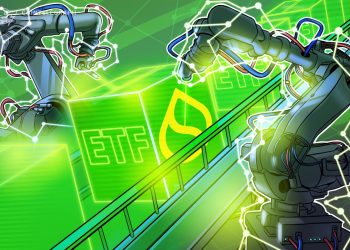In past lives, I have been a city planner, a crime boss and a CEO at a thriving crypto exchange. On Telegram, that is. Why I enjoy job cosplay is a question for my therapist. But it’s fascinating how many Web3 games explore these real-life roles. And it’s great the rewards are starting to be worth more bragging rights among your friends.
I lost endless amounts of time building my Sims town in the early-2000s, where I grew a small village into a bustling metropolis on my underpowered Windows95 desktop. I had to think through power management and food supply routes and whether or not a stadium was necessary for tax revenue to support a few more parks.
This feature is part of CoinDesk’s Web3 Marketing Week.
Fast-forward to 2009 and I am living my best Tony Soprano life with two baseball bats, a Tommy Gun, and enough property to make me one hundred and seven thousand dollars every 54 minutes in virtual currency. What “Mob Wars” had that The Sims didn’t was the network-effect power of the Facebook recommendation feed. That you could see the moves that your friends were making made you want to join into the game, and the exponential effect kept rolling and rolling.
Until Facebook put a squash on the category, as it clamped down on external notifications, taxation of virtual items, and prioritized its own features over third-party ones.
Telegram has learned some lessons from the original social media platforms, and added new modes of gamification appealing to the insatiable gambler mindset of the crypto crowd. Telegram, which has 900 million monthly users, is proving that gaming could be to be the next big player/customer acquisition platform to help grow a blockchain-forward business.
Telegram Messenger has been around for over ten years. Brothers Nikolai and Pavel Durov created the encrypted messaging platform in 2013 and soon after counted one hundred thousand users on the nascent platform.
Today, that number is approaching one billion and while not fully decentralized, its mix of strong encryption and distributed storage security make it a favorite among the crypto community. And that is before Hamster Kombat came to the platform.
Anyone in crypto looking to build an audience should be paying attention to Telegram
There have been numerous telegram crypto bots to date: services like Meme and Gif makers to GitHub notification bots, to Gmail and Spotify integrations. One application type that the crypto audience has particularly taken to is gamification. From BonkBot, which allowed simple, hyper-fast crypto flipping during the recent Solana memecoin season to Notcoin, which racked up a $1 billion in FDV after 35 million players grinded on the Telegram-based game from January to April. Clear lesson:utility plus fun, plus crypto, works well on the messaging app. A Hamster Comes Calling
The most recent entrant to catch fire in this schema is Hamster Kombat. In just over four weeks, the app has grown to over 8 million players, with more than 3 million playing daily.
The premise of Hamster Kombat is pretty straightforward. You are the CEO of a crypto exchange of your choice (Binance, OKX, MEXC and others). At first, all you do is tap the hamster on the screen to start earning some points. As soon as the available points get depleted, they start to count back up again, encouraging you to return and tap for more.
Once you have accrued enough, you, as CEO, can start to put your currency to work. You can put your points into BTC and ETH pairs yielding you hourly returns. You can spend on CoinTelegraph (or CoinDesk, if you get to level 10), or on enhancing your KYC or AML security. Each choice brings you more hourly profits back in so you can now passively earn and put more currency to work to grow your fictional exchange.
From a marketing perspective, the more you share with friends, the more you join connected channels, the more you earn to grow your business, the better. Hence the SocialFi overlay that makes the game so viral. I have seven friends, all playing through links I shared with them, which then makes me more currency to deploy to grow my empire.
Hamster Kombat allows partners to buy “cards” and for players to take actions and earn more currency per hour. Joining a partner Telegram channel may cost 15,000 points. But it pays back 3000 points per hour, making it something that has “paid” for itself in 5 hours of actively engaging with the game. This partner, a new gaming blockchain, saw their telegram subscribers swell to over 1.2 million people in just a few days after launching with Hamster Kombat, a staggeringly quick onboarding of new users in an ecosystem where attention and users are highly in demand. It was then that I felt the need to reach out and investigate what their special sauce is.
I contacted Nikita Anufriev, a marketing advisor to Hamster Kombat and host of a popular Russian language crypto channel on Youtube. Anufriev confirmed that the project was launched on March 25 of this year and it took just 11 days to reach 1 million players. Since then, it has topped 8 million players, and he stated that 2.8 million users play daily with an average use time of 52 minutes per day. Pretty staggering for a new game tied directly to a social media platform.
When asked about the genesis of the game, Anufriev gave credit to a ten year old game called USA Simulator, a mid-2010s iOS/Android game where you play as a politician with a stated goal to “Develop your country, extend the sphere of influence and lead the country to the world domination!.” He said the founders were inspired by the game and reframed it to be specifically about the crypto industry and let the users stand in the shoes of CZ (Binance) or Brian Armstrong (Coinbase).
“The viral effect started from 3 [shares per player] and now it’s closer to 15,” Anufriev said. “The in-game mechanics, like a new card, pushes you to invite friends and we saw this problem in certain regions where too many influencers started to promote it and regular people don’t have enough people to invite.” Anufriev’s team targeted an influencer audience for the first few hundred thousand users, but then the network effect took over. ”Telegram is widely popular among crypto users and is the number one messenger app for that audience,” he notes.
Telegram’s TON (Telegram Open Network), Telegram’s Layer-1 Blockchain, has been seeing serious adoption recently, and the TON token has been rising with it. But Anufriev said the project will issue its token on the Binance Smart Chain, with the end of May the target release date.
Nikita Anufriev, and many other Hamster players, will be coming to Consensus 2024 and we will see if this reward seeking community will also join together in real life or if they prefer being an anonymous player from behind a screen. For now, Telegram seems to be one place that anyone in crypto looking to build an audience should be paying attention to.


























